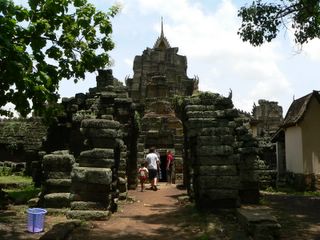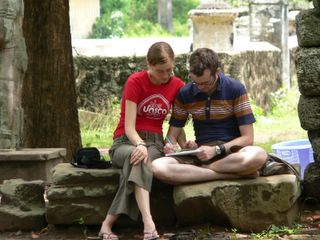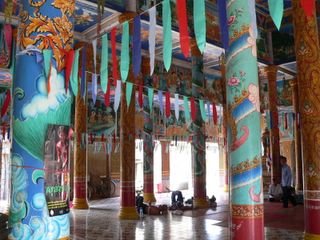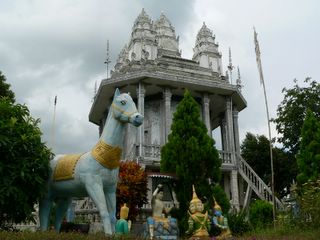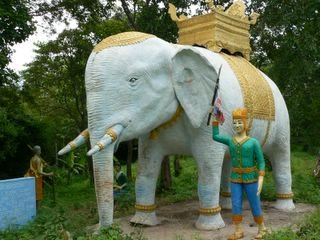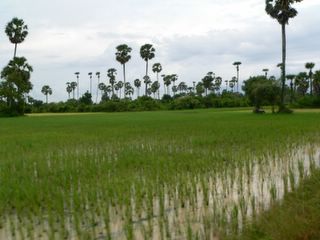The Vom
Last Sunday a group of us went to Kompong Speu for the day. It was a cosy combination – my maid, Gim Lee; Mr B, Bec and Ben and their maid, Yim; plus Melissa (who’s house Yim also cleans). Yim is Gim Lee’s aunt and they had invited us all to visit their village in Kompong Speu. Preparations for the big day had been in place for many weeks. Both Yim and Gim Lee went to great pains to make sure that there was food that we liked and that we would be comfortable.
We drove up on Sunday morning in the car. After our joyrides in the back of the ute in Kompong Cham, Ben and Bec professed to be only too happy to spend the trip in the tray with a few beers, nestled among the esky, food, soy milk products and other assorted items that were being taken over. I was a bit worried about rain, but the weather just held for the one hour trip to Kompong Speu. I was feeling a bit weary after a late night experience at “The Rock” the evening before; quite possibly the most awful entertainment venue in town. I was grumpy and finding it difficult to drive and speak Khmer at the same time. Mr B took over the wheel and I got over my initial grumpiness after Gim Lee told me that she had got up at 5 am and had started preparing our lunch at 7am, which was the same time that Yim went to the market. Ow.
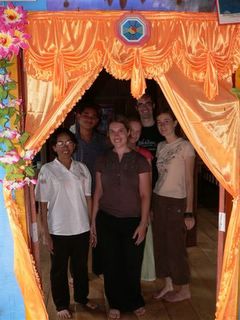
Yim's house
Everyone was in a bright mood, Yim kept on saying how happy she was that we were all going to her house and how that Andrew, Bec and Ben had helped so much and that she was so excited about them meeting her family. I didn’t fully understand the import of this until we arrived and I realised that she had been able to build a new house thanks to contributions from Mr B, B & B and others. The new house is made of wood, raised up on cement supports and literally towers over her old house which is a very small wooden shack, now used for preparation of food and storage. A new barbed wire fence spans her property. Yim showed us the inside of her new house and introduced us to her daughter, in a particularly Khmer matter of fact way “Joh goan sray khnom, goaut at sa’art” (This is my daughter, she is not beautiful”). Her house was immaculate and we immediately checked out all the photos of Yim when she was younger. She showed us her bedroom and we all spied the huge butchers knife wedged into the wooden slats of the wall, presumably kept there for protection.

Inside Yim's house
We were invited to sit on straw mats placed on bamboo slat beds underneath the house. I wanted to offer help but knew that any assistance would be refused, so instead we sat and watched all the activity. At this point there was mainly women and children assembled. I met Gim Lee’s mother and grandmother and a whole heap of cousins and aunts, whom I quickly confused. Ben had brought along boxes of “So Soya” products from the factory and so they were handed out to children and adults. We attempted to convey that some were for kids and that some were for adults but were somewhat unsuccessful, with Gim Lee’s yeay (grandmother) and other elderly women happily sipping on “So Soya for Kids” drinks.
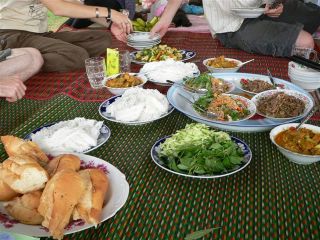
Lunch
Finally the food came out. We had arrived late for Khmer lunch and so I had an inkling that everyone must be starving. All the food was placed in our little space of honour and nobody else sat down. We asked others to join, in particular Yim, but they all refused. Often in Khmer functions people eat in shifts and we weren’t sure how much cutlery there was so after hesitating for a while we decided that we should dig in otherwise the others would never eat. It looked amazing spread out in front of us and was really yummy. Yim had made a big plate of Cha Bonlai (stir fried veggies) for me, they were hot and fresh. Mr B finally tired of our ineffectual attempts to get others to eat and started picking up plates heaped with food and placing them on the other slat bed where many of the women sat. He then cleaned his own plate, knife and fork himself with water from a huge urn and handed that over too. The women found this very strange and amusing behaviour and started laughingly calling him a “nayak bomra” (waiter or maid). As soon as the food had materialised some of the husbands also showed up on their motorbikes. As usual, I noticed that the women waited until the men had got some food before they began to eat. Finally most people had eaten something, all except for Yim. When pressed she said she wasn’t hungry. I shot back that I didn’t believe her, but she responded that she was so happy to have us all here that she didn’t need food.
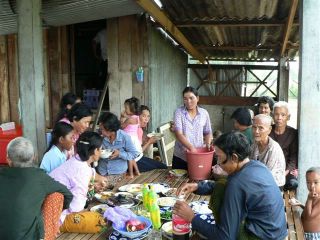
Yim's family

Ben trying Betel nut. The drug of choice for elderly women in the provinces.
After we had eaten the grey sky finally turned a darker shade and it started to very seriously rain. Even though we were all well under the house, the rain was so hard and at such an angle that many of us were getting wet. We huddled in closer and the wind whipped through the space underneath the house. Gim Lee ran off with an umbrella, perhaps to secure her house which was in another part of the village. And after one failed attempt to locate her and take her in the car, we drove with Gim Lee’s yeay and mother to their house so that we could bring her back out of the rain. After much maneuvering through muddy narrow lanes we arrived at Gim Lee’s house. Both her mother and grandmother sat in the car and I realised that they did not know how to get out. I opened the door for them and we all jumped out into the shelter of the small overhanging on their hut. Gim Lee’s house was about the same size of Yim’s old house. She introduced me to one of her brothers who was there. Gim Lee had wanted to show me her house, but once there, she and her mother seemed embarrassed about how the house was “at sa’art” (not beautiful). It was made of wood and looked extremely cramped for 5 people. It seemed to be withstanding the pelting rain though, so that was something. Gim Lee looked lovely and happy in new clothes; bright pink and red shirt with a black skirt with pink hem. She has beautiful long straight black hair which she had up in a pony-tail. She sat down on the wooden step to the house and I noticed her grandmother fussing about how her skirt did not cover her knees as she sat. I get the impression that she likes living in Phnom Penh, although her grandmother told me several times how much she misses having Gim Lee at home.
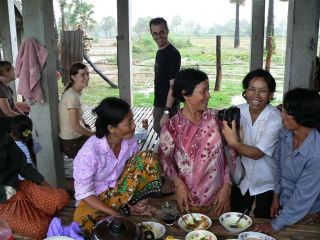
Yim showing her family photos on the digital camera
Back at Yim’s house we decided that it was time to make a move home to Phnom Penh. Yim sent a cousin off to forage around her vegetable patch and come back with several pumpkins and unidentified Khmer vegetables for us to take. She also wanted to give us all the left over food, but we refused and insisted that her family keep it. It transpired that quite a few of her family quite liked the idea of a lift in the car so we offered to take everyone back to their houses. I watched shocked as two elderly women went straight to clamber into the back of the ute. I stopped them and insisted that they sit inside the car, but it took a lot of convincing. We drove off and for once I felt somewhat Khmer with the car filled with people both inside and in the back. After depositing most people home we still had a couple of stray passengers who wanted to go all the way to Phnom Penh, including one of Gim Lee’s younger cousins who works in a garment factory just outside of Phnom Penh.
We drove slowly back in peak hour traffic. It had been an amazingly fun, but also sobering day. I felt completely overwhelmed by Yim and Gim Lee’s kindness and hospitality, and also somewhat subdued by the differences in our living circumstances and the opportunities available to us. The longer I live here it seems the less I am actually spending time with Khmer people and being part of their lives. It is so easy to forget what it is like in the villages. As we drive back to Phnom Penh we witness an accident which epitomizes one of the more negative elements of Khmer society. A drunk driver causes an accident and then physically attacks the driver of the car which he rammed into. How can someone get away with such contemptuous, criminal behaviour? He was wearing an army uniform and was obviously influential and wealthy. It seems that that in Cambodia with the good, you also get the very bad.
We drove up on Sunday morning in the car. After our joyrides in the back of the ute in Kompong Cham, Ben and Bec professed to be only too happy to spend the trip in the tray with a few beers, nestled among the esky, food, soy milk products and other assorted items that were being taken over. I was a bit worried about rain, but the weather just held for the one hour trip to Kompong Speu. I was feeling a bit weary after a late night experience at “The Rock” the evening before; quite possibly the most awful entertainment venue in town. I was grumpy and finding it difficult to drive and speak Khmer at the same time. Mr B took over the wheel and I got over my initial grumpiness after Gim Lee told me that she had got up at 5 am and had started preparing our lunch at 7am, which was the same time that Yim went to the market. Ow.

Yim's house
Everyone was in a bright mood, Yim kept on saying how happy she was that we were all going to her house and how that Andrew, Bec and Ben had helped so much and that she was so excited about them meeting her family. I didn’t fully understand the import of this until we arrived and I realised that she had been able to build a new house thanks to contributions from Mr B, B & B and others. The new house is made of wood, raised up on cement supports and literally towers over her old house which is a very small wooden shack, now used for preparation of food and storage. A new barbed wire fence spans her property. Yim showed us the inside of her new house and introduced us to her daughter, in a particularly Khmer matter of fact way “Joh goan sray khnom, goaut at sa’art” (This is my daughter, she is not beautiful”). Her house was immaculate and we immediately checked out all the photos of Yim when she was younger. She showed us her bedroom and we all spied the huge butchers knife wedged into the wooden slats of the wall, presumably kept there for protection.

Inside Yim's house
We were invited to sit on straw mats placed on bamboo slat beds underneath the house. I wanted to offer help but knew that any assistance would be refused, so instead we sat and watched all the activity. At this point there was mainly women and children assembled. I met Gim Lee’s mother and grandmother and a whole heap of cousins and aunts, whom I quickly confused. Ben had brought along boxes of “So Soya” products from the factory and so they were handed out to children and adults. We attempted to convey that some were for kids and that some were for adults but were somewhat unsuccessful, with Gim Lee’s yeay (grandmother) and other elderly women happily sipping on “So Soya for Kids” drinks.

Lunch
Finally the food came out. We had arrived late for Khmer lunch and so I had an inkling that everyone must be starving. All the food was placed in our little space of honour and nobody else sat down. We asked others to join, in particular Yim, but they all refused. Often in Khmer functions people eat in shifts and we weren’t sure how much cutlery there was so after hesitating for a while we decided that we should dig in otherwise the others would never eat. It looked amazing spread out in front of us and was really yummy. Yim had made a big plate of Cha Bonlai (stir fried veggies) for me, they were hot and fresh. Mr B finally tired of our ineffectual attempts to get others to eat and started picking up plates heaped with food and placing them on the other slat bed where many of the women sat. He then cleaned his own plate, knife and fork himself with water from a huge urn and handed that over too. The women found this very strange and amusing behaviour and started laughingly calling him a “nayak bomra” (waiter or maid). As soon as the food had materialised some of the husbands also showed up on their motorbikes. As usual, I noticed that the women waited until the men had got some food before they began to eat. Finally most people had eaten something, all except for Yim. When pressed she said she wasn’t hungry. I shot back that I didn’t believe her, but she responded that she was so happy to have us all here that she didn’t need food.

Yim's family

Ben trying Betel nut. The drug of choice for elderly women in the provinces.
After we had eaten the grey sky finally turned a darker shade and it started to very seriously rain. Even though we were all well under the house, the rain was so hard and at such an angle that many of us were getting wet. We huddled in closer and the wind whipped through the space underneath the house. Gim Lee ran off with an umbrella, perhaps to secure her house which was in another part of the village. And after one failed attempt to locate her and take her in the car, we drove with Gim Lee’s yeay and mother to their house so that we could bring her back out of the rain. After much maneuvering through muddy narrow lanes we arrived at Gim Lee’s house. Both her mother and grandmother sat in the car and I realised that they did not know how to get out. I opened the door for them and we all jumped out into the shelter of the small overhanging on their hut. Gim Lee’s house was about the same size of Yim’s old house. She introduced me to one of her brothers who was there. Gim Lee had wanted to show me her house, but once there, she and her mother seemed embarrassed about how the house was “at sa’art” (not beautiful). It was made of wood and looked extremely cramped for 5 people. It seemed to be withstanding the pelting rain though, so that was something. Gim Lee looked lovely and happy in new clothes; bright pink and red shirt with a black skirt with pink hem. She has beautiful long straight black hair which she had up in a pony-tail. She sat down on the wooden step to the house and I noticed her grandmother fussing about how her skirt did not cover her knees as she sat. I get the impression that she likes living in Phnom Penh, although her grandmother told me several times how much she misses having Gim Lee at home.

Yim showing her family photos on the digital camera
Back at Yim’s house we decided that it was time to make a move home to Phnom Penh. Yim sent a cousin off to forage around her vegetable patch and come back with several pumpkins and unidentified Khmer vegetables for us to take. She also wanted to give us all the left over food, but we refused and insisted that her family keep it. It transpired that quite a few of her family quite liked the idea of a lift in the car so we offered to take everyone back to their houses. I watched shocked as two elderly women went straight to clamber into the back of the ute. I stopped them and insisted that they sit inside the car, but it took a lot of convincing. We drove off and for once I felt somewhat Khmer with the car filled with people both inside and in the back. After depositing most people home we still had a couple of stray passengers who wanted to go all the way to Phnom Penh, including one of Gim Lee’s younger cousins who works in a garment factory just outside of Phnom Penh.
We drove slowly back in peak hour traffic. It had been an amazingly fun, but also sobering day. I felt completely overwhelmed by Yim and Gim Lee’s kindness and hospitality, and also somewhat subdued by the differences in our living circumstances and the opportunities available to us. The longer I live here it seems the less I am actually spending time with Khmer people and being part of their lives. It is so easy to forget what it is like in the villages. As we drive back to Phnom Penh we witness an accident which epitomizes one of the more negative elements of Khmer society. A drunk driver causes an accident and then physically attacks the driver of the car which he rammed into. How can someone get away with such contemptuous, criminal behaviour? He was wearing an army uniform and was obviously influential and wealthy. It seems that that in Cambodia with the good, you also get the very bad.
